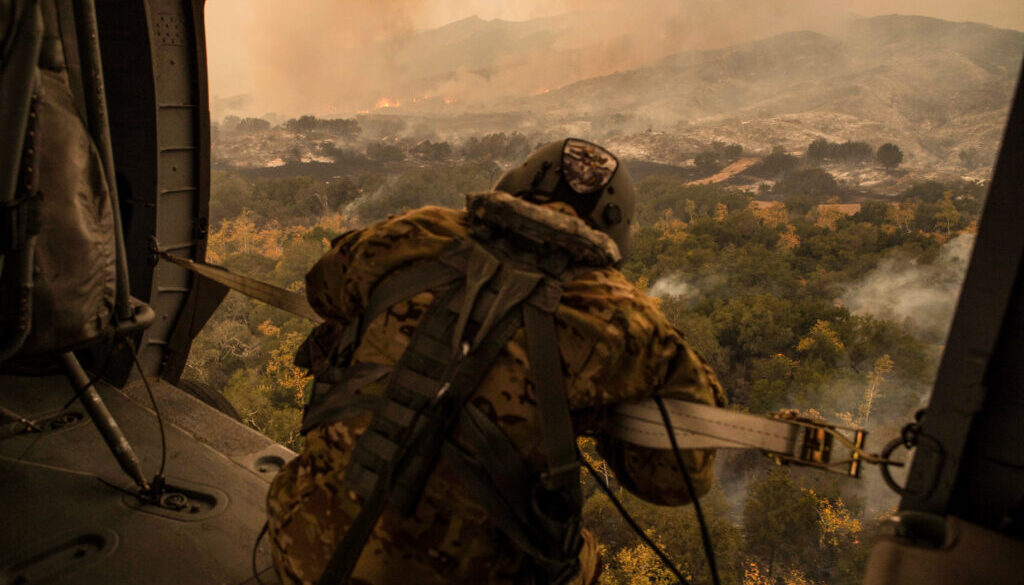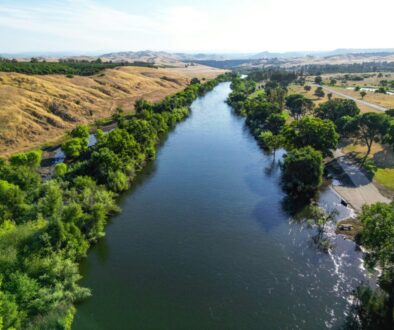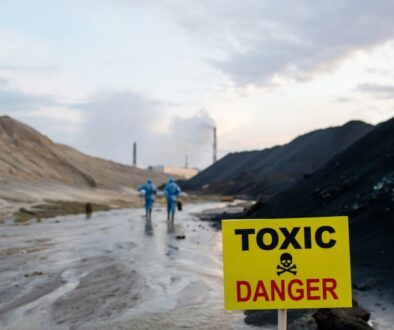Guest column: When climate is a “damn emergency,” can California move fast enough?

In September 2020, California Gov. Gavin Newsom stood amid the devastation of a wildfire that ultimately burned more than 300,000 acres, incinerated entire towns, and killed 16 people. His voice hoarse in a ghastly gray air, the governor spoke angrily.
“This a climate damn emergency,” Newsom said. “Mother Nature bats last and she bats 1,000. The debate is over around climate change.” Newsom said the state’s ambitious goals for slashing greenhouse emissions were “nice,” but not enough: “We have to step up our game.”
California has long been lauded as a leader in the fight against the most severe harms of the climate crisis — and rightly so. On multiple fronts, the state has been outpacing its neighbors for years in pursuing a range of protective strategies.
In June, Newsom signed a state budget allocating $54 billion — more than a sixth of total spending — to programs to “protect Californians from the impacts of climate change, help forge an oil-free future and tackle pollution.”
But while the talk is strong, the implementation is not and the disturbing fact is that California has fallen well behind on achieving its climate goals.
California’s climate agenda is under threat from short-sighted regulators more concerned with protecting polluters’ profits than public health and the planet’s future. The state has taken to gambling its future on unproven technologies – “carbon capture,” or sucking emissions from the air and storing them underground — that delay progress and give the fossil fuel industry a license to keep on polluting in ways that worsen the climate crisis.
High stakes
As the most populous U.S. state and the fifth-largest economy in the world, California emits as much greenhouse gases a year as the United Kingdom and France. Not often thought of as a Big Oil state, in 2020 it ranked sixth in the nation in crude oil production; if it was a country, its production would rank ahead of Australia.
Meeting the climate emergency demands action by every government and industry, but what happens in California is of huge consequence – not only for its size, but for its outsize influence on green policy.
Under Newsom’s predecessors, Arnold Schwarzenegger and Jerry Brown, California committed to reducing greenhouse gas emissions to 40 percent below 1990 levels by 2030 – roughly the benchmark scientists say is necessary to avoid catastrophic temperature rise – and to 80 percent below by 2050. The state also aims to get all electricity from carbon-free sources by 2045.
Newsom has tried to stay true to the path: He has ordered that by 2035, all new passenger cars and trucks sold must be zero-emission vehicles, a gutsy move in a state that fetishizes car culture. He has also directed the powerful California Air Resources Board, or CARB, to chart a path toward phasing out oil drilling by 2045.
But the nonprofit research group Next 10 reports that to hit the 2030 goal, emissions must be cut at more than twice the current rate, and even faster to stay on track for 2050. Progress toward non-carbon electricity has met interim targets, but still lags what’s needed.
In November, the advocacy group California Environmental Voters reported that last year legislators passed, and Newsom signed, less than half the most important climate bills introduced in Sacramento. The group gave the state its lowest-ever climate grade of D, saying: “The time to go bigger and bolder on climate was yesterday.” The same month, Assembly Speaker Anthony Rendon told the policy news site CalMatters: “I don’t at all feel that we are leading the world anymore.”
Last week, Newsom acknowledged that California is playing catch-up, saying in a letter to CARB that the state must “take even bolder action” than the agency called for in a recent update of its climate goals. An expert advisory panel had earlier blasted CARB’s update, for essentially conceding that the 2030 goal would not be met, not setting firm deadlines for ending oil and gas production, and betting on carbon capture to meet the 2050 goal.
One step forward, two steps back?
Newsom’s letter called for an energy transition “that avoids the need for more new natural gas plants,” although he was light on specifics. But disappointingly, the governor doubled down on the need for carbon capture and did not call for an earlier end to drilling. Environmental and public health advocates said he’d taken “one step forward, two steps back.”
Another giant step back looms in the specter of proposed rollbacks to the state’s solar panel program.
More than 1.4 million California homes have installed solar panels, and state law requires utilities to rebate customers the value of excess electricity their rooftops return to the grid. It’s by far the biggest solar success story in the nation, and CARB says continued strong growth is key to meeting the state’s climate goals.
But as large utilities have done nationwide, last year California’s Big Three power companies pushed the California Public Utilities Commission to slash the rebate and impose steep monthly fees on solar homeowners – a penalty projected to slow rooftop solar adoption by half or more. The PUC, long a “captured agency,” issued a proposal that amounted to a “tax on the sun.”
The outcry from solar homeowners, public interest groups, local politicians, and the press forced the PUC to pull back the proposal in February. But solar advocates still fear bad news in the commission’s revised policy, which could be released soon.
Other obstacles
The attack on solar is just one way California policymakers, from the capital to the local level, are undercutting climate goals.
• To avoid the worst global warming, the great majority of oil and gas reserves must be kept in the ground. Oil production in California is declining, but regulators have approved more than 12,000 new wells since 2019, and the 2045 target date for ending drilling means trillions more tons of emissions in the next two decades.
• In the last five years, wildfires have burned more than 10 million acres and killed 33 Californians. The risk is elevated by coastal cities and counties’ restrictive housing and lax development policies, pushing more people, homes and luxury resorts into the wildland-urban interface. But wildfires are both a result of and a contributor to the crisis. Next 10 reports that California’s emissions from wildfire smoke are now greater than from any other category except transportation – millions of tons that are not counted in reductions goals.
• The planned high-speed electric bullet train from San Francisco to Los Angeles is bogged down in cost overruns, construction delays and legislators’ squabbling over where the rails will be built first. Planners project the train could save up to 1.5 trillion tons of vehicle emissions a year if it’s running by 2035.
Too little, too late?
Can Newsom, legislators and regulators can get California back on track to meet its goals, and find the political will to follow through? Even if they can, will it be too little, too late?
Those doubts raise a more troubling question: If the incremental gains in California – birthplace of the modern environmental movement, home of prestigious universities conducting groundbreaking research, and a state where Democrats have a legislative supermajority – are the best we can do, what can we hope for elsewhere across the nation?
In Washington, D.C, climate-related legislation is held hostage by one coal-baron senator, the Supreme Court has shown itself hostile to science-based regulation, and only 1 percent of voters see the climate as a crucial issue. (In a surprise reversal, Sen. Joe Manchin of West Virginia announced late Wednesday that he will support a bill to spend $369 billion on climate and energy initiatives.)
Climate skeptics have seized on California’s setbacks to argue its regulations are only producing “suffering in the name of anti-carbon virtue,” and to proclaim that the state, and by extension the nation, should lower its sights.
With America besieged by multiple crises – the war in Europe, the pandemic, the erosion of democracy – climate defeatism is tempting. But we must keep hoping and keep trying.
As Leah Stokes, a political scientist at UC Santa Barbara and author of Short Circuiting Policy, on how utilities work to roll back clean energy laws, told New York Times columnist Farhad Manjoo: “With climate change, everything we do matters. Every ton of carbon pollution we can cut is a good thing.”
Exactly. Even when you’re in a leaky rowboat that seems to be inexorably sinking, you don’t stop bailing.
Bill Walker has more than 40 years of experience as a journalist and environmental advocate. He lives in California’s San Joaquin Valley. This is the first of a regular column for The New Lede.
(Opinion columns published in The New Lede represent the views of the individual(s) authoring the columns and not necessarily the perspectives of EWG or TNL editors.)
 EWG
EWG



August 7, 2022 @ 12:50 pm
Good artical. There is still a lot of low hanging fruit that can quickly help the fight to address climate change both directly within the state but also to set an example to the world ~ and we need quickly, we don’t have time to wait. Examples could include:
*Energy Star to immediate become the minimum required for goods to be sold in CA (phase in a ban on dry cycle as the default for dishwashers, 40C as default for washing machine cycles)
*Set up a tiered structure for required use of low CO2 concrete so structural parts can remain but general purpose has to switch quickly.
*Same for steel use.
*Ban glass or aluminum water bottles/containers. Set maximum weight for drink bottles sold in stores and restaurants -different for carbonated and still ( faster and more impactful than recycling initiatives).
*Ban sale of automatic flushing urinals and public sink faucets that don’t shut off
immediately, set a schedule for their replacement.
*Set enforceable minimum and maximum thermostat settings for public buildings. Different values for occupied and unoccupied (including offices, shops etc). There are still buildings cooled to a stupid degree in the summer, and can be kept that way overnight. helps with climate change and energy security.
August 4, 2022 @ 7:25 pm
Itís hard to come by educated people about this topic, however, you seem like you know what youíre talking about! Thanks